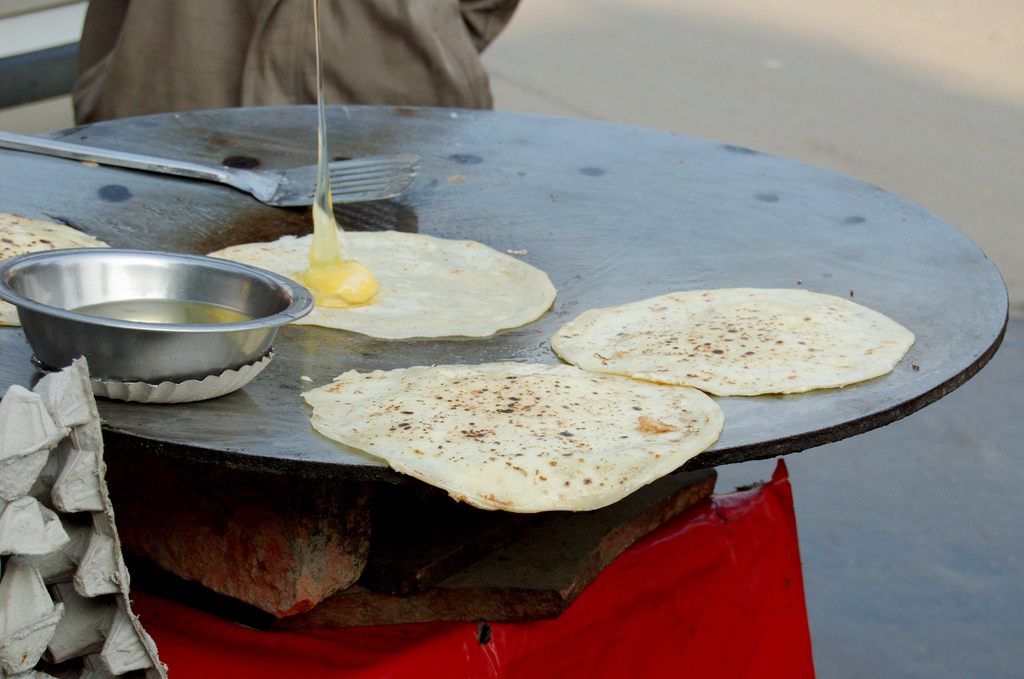The Kati Roll Can Be Traced Back to One Kolkata Restaurant
How the kati roll went from street snack to global trend.

A stack of kati rolls served on a plate in Kolkata. (Photo: Satyajit Dhawale (Satyajit888)/CC BY-SA 4.0)
Behold, the kati roll: the spicy street wrap that is springing up in cities all over the world. It is not unusual to see revelers heading to a kati roll stand at the end of a night out in Manhattan, or besuited office workers standing patiently in lunch lines at kati roll spots in London.
The kati roll was invented in the first half of the 20th century in the city of Kolkata, India, and its origins can actually be traced back to a single restaurant, known as Nizam’s. At the time of the kati roll’s conception, Kolkata was the capital of the British Empire. The story goes that British patrons did not want to eat kebabs with their hands, so someone at Nizam’s decided to roll the meat up in a paratha–a crispy, buttery unleavened flatbread–and then serve it in a paper wrapper.
Although no official version of this story exists, it is generally agreed upon that the kati roll concept came out of Nizam’s. Nizam’s began as a stall vending kebabs and parathas, and expanded into a brick-and-mortar restaurant in 1932. In fact, the restaurant is still going strong in the city’s New Market area, and continues to be considered one of the best places in the city for a kati roll.

A kati roll being prepared in a street vendor’s stall in Kolkata, India. (Photo: Scott Dexter/CC BY-SA 2.0)
The new snack quickly gained popularity among the masses. In its original form, a kati roll consisted of skewer-roasted kebabs wrapped in paratha, layered with eggs and topped with chutney. Soon, vegetarian filling options such as paneer and chickpeas were offered as an alternative to kebab meat. As food critic Vir Sanghvi writes in an essay about kati rolls, a kati roll is a dish in itself–not a wrap designed as a means to eat kebabs on the run.
At some point in the 1960s, Nizam’s swapped out the traditional metal skewers used to cook the kebab meat for bamboo ones. The heavy iron skewers, though long-lasting, were too expensive to buy in the amount necessary to meet the growing demand. It was the new bamboo sticks used to replace the iron skewers which led to the name, “kati roll,” as the word kathi in Bengali means “stick.”
Before the kati roll found sophisticated new digs in cities around the world, it was most commonly seen at street vendors in Kolkata, which embraced the dish after Nizam’s popularized it. Indeed, the dish finds its finest form when it is cooked in front of diners. After you place your order at one such stall, the cook rolls out the dough onto a flat griddle or pan known as the tawa, cracks an egg onto it, and rolls in the spicy fillings. The whole thing is wrapped in paper and presented to you piping hot, in a matter of minutes from when you placed your order.

Kati rolls are made by wrapping a hot egg paratha around either kebab meat or vegetables–the perfect snack food. (Photo: Josiah Lau Photography/CC BY-ND 2.0)
While the kati roll rapidly gained popularity in Kolkata for its delicious range of fillings and its portability, it did not really get similar traction in other Indian cities. As Sanghvi explains, other cities each have their own version of the roll–such as the Frankie roll in Mumbai and the Khan Chacha roll in Delhi, which have little in common with the original Nizami roll from Kolkata.
When the kati roll crossed Indian borders, however, it was a different story: the delicacy caught on like wildfire. Businesswoman Payal Saha, who hails from Kolkata, lays claim to being the first person to bring the kati roll concept to the United States. Saha owns the popular Kati Roll Company chain of restaurants, which she established in 2002. There are now three outlets in Manhattan, and one in London.
Following the kati roll’s introduction to the United States, new storefronts that specialize in the snack have opened at a brisk pace. If you’re lucky enough to have one near you, stop by to grab a taste of what made Nizam’s famous all those years ago.
Gastro Obscura covers the world’s most wondrous food and drink.
Sign up for our email, delivered twice a week.























Follow us on Twitter to get the latest on the world's hidden wonders.
Like us on Facebook to get the latest on the world's hidden wonders.
Follow us on Twitter Like us on Facebook